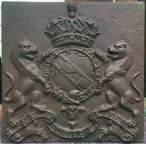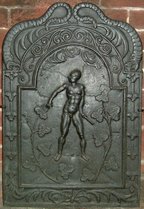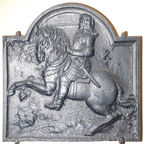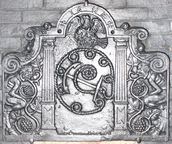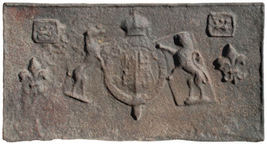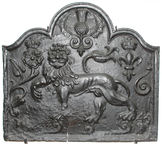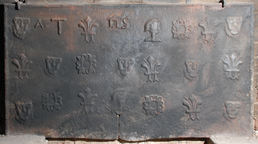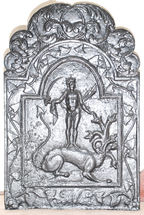-
390
Description: Rectangular; plain plate with shield, supporters, ducal coronet, motto and garter of the Duke of Dorset: Quarterly, Or and gules, a bend vair.
Notes: Almost certainly the arms of Lionel Sackville KG (1688-1765), created first duke of Dorset in 1720. This particular design of fireback has been produced in a variety of sizes depending on the space around the achievement of arms
Copies of this fireback are known.
Inscription: HONI SOIT QUI MAL Y PENSE / AUT NUNQUAM TENTES, AUT PERFICE [Either do not attempt, or complete]
Arms: Lionel Sackville, 1st Duke of Dorset
- Decoration tags:
- rectangular (shape)
- none (edging)
- whole carved pattern
- armorial
- text
Manufactured: in the early-18th century in the Weald area of England.
Current location: in private hands Milford, Surrey, England.
Citation: Lloyd, N., 1925, 'Domestic Ironwork I', Architectural Review, 58, pp. 58-67.
- Attached to series:
- Dorset arms series
- Personal armorial firebacks
- Sackville firebacks
-
500
Description: Arched rectangular shaped central panel with astragal and fillet edge, pictorial, a bald, naked man, standing on a mound, holding a baton in his left hand, surrounded by leaf fronds to left and right, and clouds above; arched rectangular shaped border, fillet edging, hanging leaf clusters to left and right, swirled lines above, and draped foliage with monogram at base; on top are two serpents and draped foliage.
Notes: The figure may represent Pheidippides, the messenger between Athens and Sparta during the Battle of Marathon in 490BC.
Copies of this fireback are known.
Inscription: TAN
- Decoration tags:
- 'Dutch' (shape)
- fillet (edging)
- whole carved pattern
- pictorial
- mythological
- monogram
- text
- humans
Manufactured: in the early-18th century probably at Ashburnham Furnace in the Weald area of England.
Current location: West Berkshire Museum, Newbury, Berkshire, England.
Citation: Lloyd, N., 1925, 'Domestic Ironwork I', Architectural Review, 58, pp. 58-67.
- Attached to series:
- TAN series
- British 'Dutch' style firebacks
-
523
Description: Arched rectangular shape; cavetto-moulded edging; figure in mid-17th century armour, sword in belt, riding a prancing horse; initials split, below corners of arch, in front of horse’s head and behind rider’s back.
Notes: Probably intended to represent Charles I in memoriam, as other firebacks in this style date from the end of the Commonwealth period. Mitford collection, Petworth House. Copies of this fireback were advertised in the Wayte & Cheverton (Edenbridge) catalogue in the early-20th century, and inferior copies in Kings Worthy Foundry's (Winchester) catalogue in the mid-20th century.
Copies of this fireback are known.
Inscription: [C missing] R
- Decoration tags:
- rectangular with round arch (shape)
- cavetto (edging)
- whole carved pattern
- pictorial
- text
- animals
- humans
Manufactured: in the mid-17th century in the Weald area of England.
Current location: Petworth House, Petworth, West Sussex, England.
Museum number: NT/PET/M/77 (part of the National Trust museum group)
Citation: Baines, J. M., 1958, Wealden Firebacks (Hastings Museum).
Citation: Lloyd, N., 1925, 'Domestic Ironwork I', Architectural Review, 58, pp. 58-67.
- Attached to series:
- Small cavetto series
- Miscellaneous royal firebacks
-
585
Description: Central arched rectangular shape formed of fluted Ionic pilasters supporting a rounded arch, with fillet edging, bearing the date between two flower heads; beneath is a fouled anchor within a circlet of rope gathered into eight loops; a phoenix, its wings displayed and inverted, rises from the flames above the rope; mirrored outside each pilaster, a crouching, naked faun, facing inwards, disgorges a vine with bunches of grapes; above each faun a volute forms the top corner of the plate.
Notes: The decorative elements of this fireback have yet to be fully interpreted; the vines disgorged from the mouths of the fauns are related to the 'green man' tradition associated with woodland spirits and symbolising resurrection, the latter echoed by the phoenix, though in the form in which they appear on this fireback they may be a purely decorative device. By contrast, the cabled anchor is the badge of the Lord High Admiral who, in 1608, was Charles Howard, 1st Earl of Nottingham (previously Lord Howard of Effingham). A pastiche of this fireback, dated 1633, is also known (no. 1064).
Copies of this fireback are known.
Inscription: 1608
- Decoration tags:
- rectangular with canted top corners and round arch (shape)
- fillet (edging)
- whole carved pattern
- pictorial
- mythological
- text
- humans
- plants
- objects
Manufactured: in 1608 in the Weald area of England.
Current location: Petworth House, Petworth, West Sussex, England.
Museum number: NT/L/PET/M/117.1 (part of the National Trust museum group)
Citation: Lloyd, N., 1925, 'Domestic Ironwork I', Architectural Review, 58, pp. 58-67.
- Attached to series:
- Miscellaneous pattern firebacks
- Phoenix firebacks
-
1191
Description: Rectangular; twisted rope edging (top and sides only); eight shields of Ayloffe impaling Sulyard in three rows, 3-2-3; Ayloffe: sable, a lion rampant Or, collared gules, between three crosses formy of the second; Sulyard: argent, a chevron gules between three pheons inverted sable.
Notes: William Ayloffe (c1535-1584) of Bretons, Hornchurch, Essex, Justice of the Court of Queen’s Bench, married (c1560) Jane, dau. of Sir Eustace Sulyard, of Runwell, Essex. Illustrated in Lloyd (1925).
Arms: Ayloffe impaling Sulyard (William Ayloffe of Bretons, Hornchurch)
- Decoration tags:
- rectangular (shape)
- rope (edging)
- carved stamps
- heraldic
- armorial
Manufactured: in the early-17th century in the Weald area of England.
Current location: Great Dixter, Northiam, East Sussex, England.
Citation: Lloyd, N., 1925, 'Domestic Ironwork I', Architectural Review, 58, pp. 58-67.
- Attached to series:
- Ayloffe series
- Personal armorial firebacks
-
470
Description: Rectangular; twisted rope edging (top and sides); central Tudor royal shield with encircling garter (motto reversed), separate greyhound and lion supporters, separate crown; rectangular bordered stamp with an animal facing to the right, repeated once above and on each side of the armorial; bold fleur-de-lys stamp repeated once on each side of the armorial below the other stamp; all irregularly positioned.
Notes: The armorial and fleurs-de-lys are seen together on a plate at Alfriston Clergy House.
Copies of this fireback are known.
Arms: Tudor royal (prob. Elizabeth I)
- Decoration tags:
- rectangular (shape)
- rope (edging)
- carved stamps
- heraldic
- armorial
- royal
- objects
Manufactured: in the mid- to late-16th century possibly at Pounsley Furnace, Framfield in the Weald area of England.
Current location: not known.
Citation: Lloyd, N., 1925, 'Domestic Ironwork I', Architectural Review, 58, pp. 58-67.
-
736
Description: Other examples indicate that this fireback comprises at least four separate elements: the rectangular central panel has an anchor with coiled rope between two fleurs de lys, below which are two roses; this arrangement is repeated alongside; the two rectangular side panels each comprise a vertical stem with six ‘raspberries’ surmounted by a circular berry cluster; above, a semicircular arch contains the initials between two roses as in the central panel, with the date above; where the arch meets the central panel there is an arc across each corner; on the rectangular base panel, on a stippled ground, is a central six-pointed star and a four-strand root system beneath each of the stems in the side panels. The top and sides panels are edged with simulated twisted rope.
Notes: One of an unusual series formed from separate panels arranged, in this instance, with each vertical panel repeated. Because of its date and the use of the anchor motif, this much-copied plate is often referred to as the Armada fireback. No other connection with the sea battle is known. Other firebacks have been cast using some of the separate elements described above. The bottom panel which, unlike the other panels is separately edged with twisted rope, is likely to have been an addition to a copy of an earlier casting (no. 822) and not original.
Copies of this fireback are known.
Inscription: 1588 / IFC
- Decoration tags:
- rectangular with round arch (shape)
- simulated rope (edging)
- carved pattern panels
- text
- plants
- objects
Manufactured: in the late-16th century in the Weald area of England.
Current location: Victoria & Albert Museum, Cromwell Road, Kensington & Chelsea, Greater London, England.
Museum number: M.77-1957 (part of the Victoria & Albert Museum museum group)
Citation: Lloyd, N., 1925, 'Domestic Ironwork I', Architectural Review, 58, pp. 58-67.
- Attached to series:
- Armada series
-
763
Description: Quasi-Arched rectangular shape with cyma reversa shoulders; ovolo edging; stylised lion passant guardant; crowned rose with leaf and stem on left, crowned fleur de lys on right, thistle with leaves above centre; three right-facing scrolls at base; down-facing scroll, with staple, on right side; date split between bottom corners; initials below date, bottom right.
Notes: Blatantly Royalist in its symbolism, a variant (no. 901) is dated (perhaps more convincingly) 1641. Numeral style, initials, leaf depiction and the stapled scroll are typical features of firebacks made from patterns by the same maker. A later version of the same subject, but with a different shaped plate and without the fleur-de-lys, is also known (see 'Royalist series'). M. A. Lower writes of firebacks of this design of being cast at Waldron Furnace in Sussex (Lower, 1849, p.219). Copies were advertised in F. Parkin & Sons (Exeter) catalogue in 1972.
Copies of this fireback are known.
Inscription: 16 49 / IM
- Decoration tags:
- rectangular with round arch (shape)
- ovolo (edging)
- whole carved pattern
- heraldic
- royal
- text
- animals
Manufactured: in 1649 possibly at Brede Furnace in the Weald area of England.
Current location: Victoria & Albert Museum, Cromwell Road, Kensington & Chelsea, Greater London, England.
Museum number: 492.1901 (part of the Victoria & Albert Museum museum group)
Citation: Lloyd, N., 1925, 'Domestic Ironwork I', Architectural Review, 58, pp. 58-67.
- Attached to series:
- IM series
- Hooked '1' series
- Stapled scroll series
- Brede group
-
801
Description: Rectangular; twisted rope edging (top and sides); irregular arrangement of four stamps in three rows: face mask with ruff (7), flower head with four petals and leaflets (4), fleur-de-lys (7), and profile of head with ‘Roman’ crest (2); initials replace stamps top left and centre.
Notes: A smaller, dated variant is at Godolphin House, Helston.
Copies of this fireback are known.
Inscription: AT nS
- Decoration tags:
- rectangular (shape)
- rope (edging)
- carved stamps
- individual letters
- heraldic
- text
- humans
- plants
Manufactured: in the early-17th century in the Weald area of England.
Current location: The Dorset Arms, Withyham, East Sussex, England.
Citation: Lloyd, N., 1925, 'Domestic Ironwork I', Architectural Review, 58, pp. 58-67.
- Attached to series:
- Primitive stamp series
-
803
Description: Arched rectangular central panel, astragal and fillet edge, pictorial, Hercules, sword in hand, preparing to slay the Hydra; Arched rectangular border, fillet edge, ivy leaves and tendrils, monogram at bottom; swirled foliage on top.
Notes: The wooden pattern for this fireback (no. 927), formerly in the custody of William Hobday (d. 1883), last surviving ironworker at Ashburnham furnace, was given to the Sussex Archaeological Society by the Revd. J. Bickersteth. The fireback was previously at a house at Hooe, East Sussex.
Copies of this fireback are known.
Inscription: TAN
- Decoration tags:
- 'Dutch' (shape)
- fillet (edging)
- whole carved pattern
- pictorial
- mythological
- monogram
- text
- humans
Manufactured: in the 18th century at Ashburnham Furnace in the Weald area of England.
Current location: in private hands, Crawley, West Sussex, England.
Citation: Butterfield, W. R., 1916, 'Old Wealden Firebacks', The Connoisseur, 46, pp. 197-209.
Citation: Lloyd, N., 1925, 'Domestic Ironwork I', Architectural Review, 58, pp. 58-67.
Citation: Straker, E., 1931, Wealden Iron (London, Bell).
- Attached to series:
- TAN series
- British 'Dutch' style firebacks
